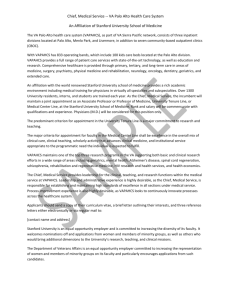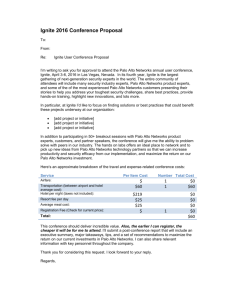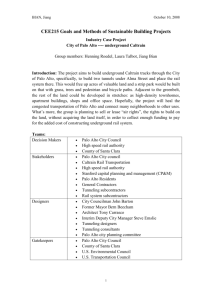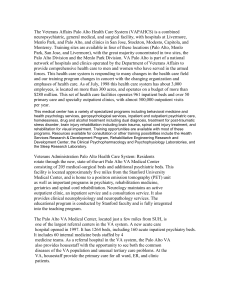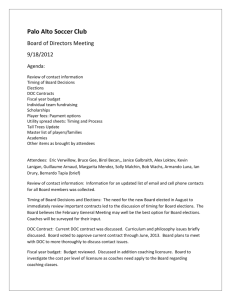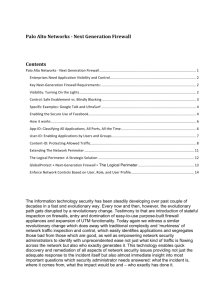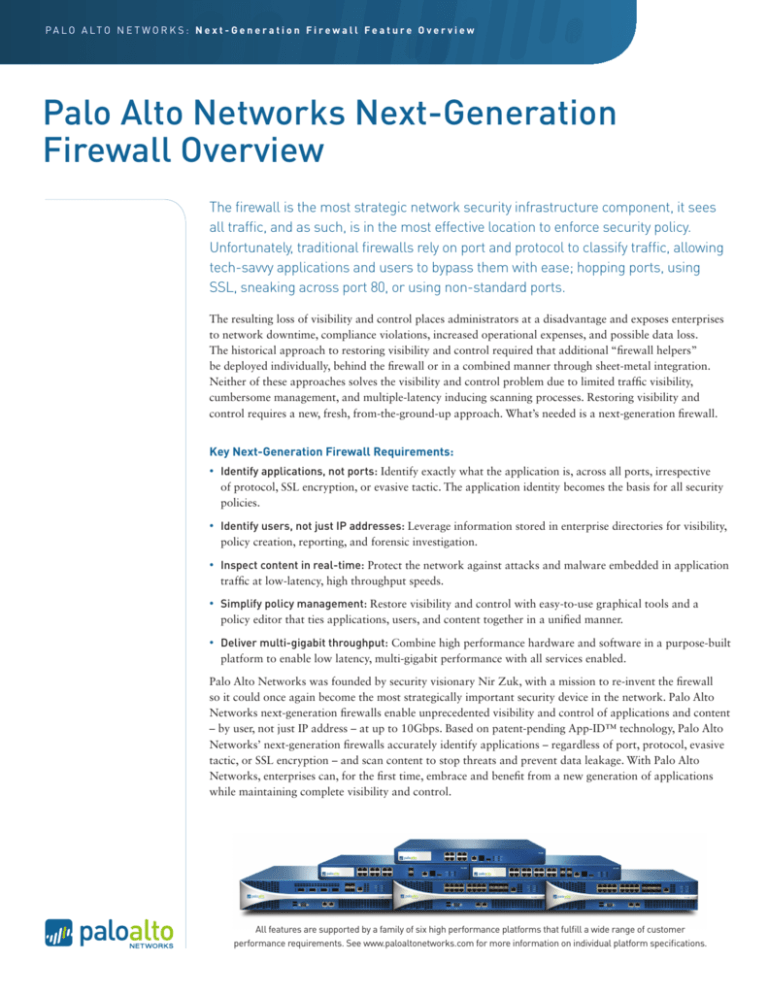
PA L O A LT O N E T W O R K S : N e x t - G e n e r a t i o n F i r e w a l l F e a t u r e O v e r v i e w
Palo Alto Networks Next-Generation
Firewall Overview
The firewall is the most strategic network security infrastructure component, it sees
all traffic, and as such, is in the most effective location to enforce security policy.
Unfortunately, traditional firewalls rely on port and protocol to classify traffic, allowing
tech-savvy applications and users to bypass them with ease; hopping ports, using
SSL, sneaking across port 80, or using non-standard ports.
The resulting loss of visibility and control places administrators at a disadvantage and exposes enterprises
to network downtime, compliance violations, increased operational expenses, and possible data loss.
The historical approach to restoring visibility and control required that additional “firewall helpers”
be deployed individually, behind the firewall or in a combined manner through sheet-metal integration.
Neither of these approaches solves the visibility and control problem due to limited traffic visibility,
cumbersome management, and multiple-latency inducing scanning processes. Restoring visibility and
control requires a new, fresh, from-the-ground-up approach. What’s needed is a next-generation firewall.
Key Next-Generation Firewall Requirements:
•
Identify applications, not ports: Identify exactly what the application is, across all ports, irrespective
of protocol, SSL encryption, or evasive tactic. The application identity becomes the basis for all security
policies.
•
Identify users, not just IP addresses: Leverage information stored in enterprise directories for visibility,
policy creation, reporting, and forensic investigation.
•
Inspect content in real-time: Protect the network against attacks and malware embedded in application
traffic at low-latency, high throughput speeds.
•
Simplify policy management: Restore visibility and control with easy-to-use graphical tools and a
policy editor that ties applications, users, and content together in a unified manner.
•
Deliver multi-gigabit throughput: Combine high performance hardware and software in a purpose-built
platform to enable low latency, multi-gigabit performance with all services enabled.
Palo Alto Networks was founded by security visionary Nir Zuk, with a mission to re-invent the firewall
so it could once again become the most strategically important security device in the network. Palo Alto
Networks next-generation firewalls enable unprecedented visibility and control of applications and content
– by user, not just IP address – at up to 10Gbps. Based on patent-pending App-ID™ technology, Palo Alto
Networks’ next-generation firewalls accurately identify applications – regardless of port, protocol, evasive
tactic, or SSL encryption – and scan content to stop threats and prevent data leakage. With Palo Alto
Networks, enterprises can, for the first time, embrace and benefit from a new generation of applications
while maintaining complete visibility and control.
All features are supported by a family of six high performance platforms that fulfill a wide range of customer
performance requirements. See www.paloaltonetworks.com for more information on individual platform specifications.
PA L O A LT O N E T W O R K S : N e x t - G e n e r a t i o n F i r e w a l l F e a t u r e O v e r v i e w
Unique Identification Technologies Enable Palo Alto Networks’ Next-Generation Firewall
There are three unique technologies within the Palo Alto Networks’ next-generation firewall that enable visibility and control
over applications users and content: App-IDTM, User-ID, and Content-ID. Each of the three technologies are industry firsts and are
delivered in the form of a purpose-built firewall platform that helps administrators restore visibility and control. A complete set of
traditional firewall, management, and networking features allows customers to deploy a Palo Alto Networks next-generation firewall
into any networking environment.
•
•
App-IDTM: The first firewall traffic classification engine to use
as many as four different mechanisms to accurately identify
exactly which applications are running on the network,
irrespective of port, protocol, SSL encryption, or evasive
tactic employed. The determination of the application
identity is the first task performed by the firewall and that
information is then used as the basis for all firewall policy
decisions.
User-ID: Seamless integration with enterprise directory
services such as Active Directory, eDirectory, LDAP,
and Citrix is unique to Palo Alto Networks and enables
administrators to view and control application usage based
on individual users and groups of users, as opposed to just
IP addresses. User information is pervasive across all features
including application and threat visibility, policy creation,
forensic investigation, and reporting.
A stream-based scanning engine uses a uniform
signature format to block a wide range of threats and
limit the transfer of unauthorized files and sensitive data,
while a comprehensive URL database controls web surfing.
The breadth of threat prevention, done in a single pass, is
unique to Palo Alto Networks and when combined with the
application visibility and control delivered by App-ID, IT
departments regain control over applications and related
threats.
Application Protocol
Detection / Decryption
Application Protocol
Decoding
Application Signature
Heuristics
10.0.0.277
Role
Login
10.0.0.211
Discovery
Monitoring
10.0.0.282
10.0.0.290 10.0.0.239
User-ID
10.0.0.242
10.0.0.265 10.0.0.209
10.0.0.287 End Station
Captive
Portal
10.0.0.232 Polling
10.0.0.221
Paul
Engineering
Steve
Finance
Nancy
Marketing
Finance
Group
•Content-ID:
•
Purpose-built Platform: Multi-Gbps throughput is enabled
through function-specific processing for networking, security,
threat prevention and management, which are tightly
integrated with a single pass software engine to maximize
throughput. A 10Gbps data plane smoothes traffic flow
between processors while the physical separation of control
and data plane ensures that management access is always
available, irrespective of traffic load.
THREATS
DATA
CC #
SSN
Files
Web Filtering
Content-ID
App-ID
Policy En
Networ
Manage
Contro
gine
User-ID
Conten
king
Single Pa
ss
Software
t-ID
Content
ment
Security
l Plan
e
Network
Data Pl
PAGE 2
URLS
Vulnerability Exploits
Viruses
Spyware
ing
ane
PA L O A LT O N E T W O R K S : N e x t - G e n e r a t i o n F i r e w a l l F e a t u r e O v e r v i e w
Application Visibility
View application activity in a
clear, easy-to-read format.
Add and remove filters to learn
more about the application, its
functions and who is using them.
Visibility into Applications, Users and Content
Administrators are in a race to keep up with users that are
increasingly tech-savvy and applications that are technically
advanced as well as easy to use. Making the race more
difficult is the fact that the tools in the administrator’s arsenal
are unable to provide them with up-to-date information on
network activity. With a Palo Alto Networks next-generation
firewall, administrators can use a powerful set of visualization
tools to quickly see the applications traversing the network,
who is using them, and the potential security impact. The
visibility that the Application Command Center (ACC), AppScope, log viewer, and fully customizable reporting provides
can empower administrators to implement more businessrelevant security policies.
•
Application Command Center (ACC): A standard feature
that requires no configuration effort, ACC graphically
displays a wealth of information on current network activity
including applications, URL categories, threats, and data. If
a new application appears in ACC, a single click displays a
description of the application, its key features, its behavioral
characteristics, who is using it, and what security rules
allowed it to be used. Additional filters can be added to learn
more about application use for individual users along with
the threats detected within the application traffic. In the span
of just a few minutes, ACC provides administrators with
the data they need to make more informed security policy
decisions.
PAGE 3
•
App-Scope: Complementing the real-time view of
applications and content provided by ACC, App-scope
provides a dynamic, user-customizable view of application,
traffic and threat activity over time.
•
Management: To accommodate different management styles,
requirements, and staffing, administrators can use the webbased interface, a complete Command Line Interface (CLI),
or a centralized management solution (Panorama) to control
all aspects of the Palo Alto Networks firewall. For those
environments where different staff members require varied
levels of access to the management interface, role-based
administration across all three management mechanisms
enables the delegation of administrative functions to the
appropriate individual. Standards-based syslog and SNMP
interfaces enable integration with 3rd party management
tools.
•
Logging and Reporting: Real-time filtering facilitates rapid
forensic investigation into every session traversing the
network. Pre-defined, fully customizable and schedulable
reports provide detailed views into applications, users, and
threats on the network.
PA L O A LT O N E T W O R K S : N e x t - G e n e r a t i o n F i r e w a l l F e a t u r e O v e r v i e w
Enabling Appropriate Application Usage Policies
Immediate access to the knowledge of which applications are
traversing the network, who is using them, and the potential
security risk empowers administrators to quickly and easily
determine the appropriate response. Armed with these data
points, administrators can apply policies with a range of
responses that are more fine-grained than allow or deny. Policy
control responses include:
•
•
•
•
•
•
•
•
Allow or Deny
Allow, but scan for viruses and other threats
Allow based on schedule, users, or groups
Decrypt and inspect
Apply traffic shaping through QoS
Apply policy-based forwarding
Allow certain application functions
Any combination of the above
Using a policy editor that carries a familiar look and feel,
experienced firewall administrators can quickly create
flexible firewall policies such as:
•
Assign Salesforce.com and Oracle access to the sales and
marketing groups by leveraging Active Directory integration.
• Enable only the IT group to use a fixed set of management
applications such as SSH, telnet, and RDP.
Policy Editor
A familiar look and
feel enables the rapid
creation and deployment
of firewall policies that
control applications,
users and content.
PAGE 4
•
•
•
•
•
•
•
Block bad applications such as P2P file sharing, circumventors,
and external proxies.
Define and enforce a corporate policy that allows and inspects
specific webmail and instant messaging usage.
Use policy-based forwarding to force Facebook application
traffic over a specific route.
Control the file transfer functionality within an individual
application, allowing application use yet preventing file
transfer.
Identify the transfer of sensitive information such as credit
card numbers or social security numbers, either in text or file
format.
Deploy URL filtering policies that block access to obvious
non-work related sites, monitor questionable sites, and
“coach” access to others.
Implement QoS policies to allow media and other bandwidth
intensive applications but limit their impact on business critical
applications.
With a Palo Alto Networks next-generation firewall in place,
customers can deploy positive enforcement model policies to
block bad applications, scan business applications for threats
and promote the secure use of end-user applications.
PA L O A LT O N E T W O R K S : N e x t - G e n e r a t i o n F i r e w a l l F e a t u r e O v e r v i e w
Content and Threat Visibility
View URL, threat and file/data transfer
activity in a clear, easy-to-read format. Add
and remove filters to learn more about
individual elements.
Protecting the Network from Threats
Regaining visibility and control over application traffic
solves only part of the network security challenge that IT
departments face with today’s Internet-centric environment.
Inspecting permitted application traffic becomes the next
significant challenge and one that is addressed by a threat
prevention engine that is tightly integrated with the firewall,
combining a uniform signature format and stream-based
scanning to block vulnerability exploits, viruses, and
spyware in a single pass.
•
Intrusion Prevention System (IPS): The vulnerability
protection integrates a rich set of intrusion prevention
system (IPS) features to block known and unknown
network and application-layer vulnerability exploits,
buffer overflows, DoS attacks, and port scans from
compromising and damaging enterprise information
resources. IPS mechanisms include:
•
•
•
•
•
•
•
•
•
Protocol decoder analysis
Stateful pattern matching
Protocol anomaly detection
Heuristic-based analysiss
Statistical anomaly detection
IP defragmentation and TCP reassembly
Block invalid or malformed packets
Custom vulnerability signatures
Network Antivirus: Inline antivirus protection
detects and blocks most types of malware at the
gateway. Antivirus protection leverages the uniform
signature format and stream-based engine to protect
PAGE 5
enterprises from millions of malware variants. Streambased scanning helps protect the network without
introducing significant latency – which is the problem
with other network AV technologies that rely on
proxy-based scanning. Furthermore, the stream-based
engine can perform in-line decompression, protecting
enterprises from zipped or compressed threats, and
because Palo Alto Networks’ next-generation firewalls
have the ability to decrypt SSL by policy, organizations
are further protected from malware moving across SSL
encrypted application vectors.
URL Filtering
A fully-integrated, customizable URL filtering database of 20
million URLs across 76 categories allows administrators to
apply granular web-browsing policies, complementing
application visibility and control policies and safeguarding the
enterprise from a full spectrum of legal, regulatory, and
productivity risks. Custom categories can be created to
complement the on-box URL database and address unique
customer requirements. To suit local user community traffic
patterns, the on-box database can also be augmented with a
separate, dynamic 1 million URL cache database generated
from a hosted, 180 million URL database.
Data Filtering
Data filtering features enable administrators to implement
policies that will reduce the risks associated with the transfer
of unauthorized files based on type (as opposed to looking
only at the file extension) and confidential data patterns (credit
card and social security numbers).
PA L O A LT O N E T W O R K S : N e x t - G e n e r a t i o n F i r e w a l l F e a t u r e O v e r v i e w
Network Deployment Flexibility
Bandwidth Monitoring and Control
A flexible networking architecture that includes dynamic
routing, switching, high availability, and VPN support enables
deployment into nearly any networking environment.
•
Quality of Service (QoS): Traffic shaping extends
the positive enablement policy controls to provide
administrators with the ability to allow bandwidth intensive
applications such as streaming media, while preserving
the performance of business applications. Traffic shaping
policies (guaranteed, maximum, and priority) can be
enforced based on application, user, schedule, and more.
Diffserv marking is also supported, enabling application
traffic to be controlled by a downstream or upstream device.
•
Real-time Bandwidth Monitor: Real-time graphical view
of bandwidth and session consumption for applications and
users within a selected QoS class.
•
Switching and Routing: L2, L3 and mixed mode support
combined with zone-based security enables deployment into
a wide range of network environments. Dynamic routing
protocols (BGP, OSPF and RIP) and full 802.1Q VLAN
support is provided for both L2 and L3.
•
Virtual Wire: Logically bind two ports together and pass all
traffic to the other port without any switching or routing,
enabling full inspection and control with no impact on the
surrounding devices.
•
Policy-based Forwarding: Forward traffic based on
policy defined by application, source zone/interface,
source/destination address, source user/group, and
service.
•
Virtual Systems: Create multiple virtual “firewalls”
within a single device as a means of supporting specific
departments or customers. Each virtual system can
include dedicated administrative accounts, interfaces,
networking configuration, security zones, and policies for
the associated network traffic.
•
Active/passive High Availability: Sub-second failover
with full support for configuration and session
synchronization.
•
IPv6: Full application visibility, control, inspection,
monitoring, and logging for applications using IPv6 is
supported (Virtual Wire mode only).
•
Jumbo Frames (PA-4000 Series only): Jumbo frames (up
to 9,216 bytes) are supported.
Secure Connectivity
•
Site-to-site VPN: Standards-based IPSec VPN
connectivity combined with application visibility and
control enables protected communications between two
or more Palo Alto Networks devices or another vendor’s
IPSec VPN device.
•
Remote Access VPN: SSL tunnel VPN provides secure
network access for remote users and extends policy-based
visibility and control over applications, users, and content
to those users.
Palo Alto Networks
232 E. Java Drive
Sunnyvale, CA. 94089
Sales 866.320.4788 408.738.7700
www.paloaltonetworks.com
Reporting and Logging
Powerful reporting and logging enables analysis of security
incidents, application usage, and traffic patterns.
•
Reporting: Predefined reports can be used as-is,
customized, or grouped together as one report in order to
suit the specific requirements. A detailed activity report
shows applications used, URL categories visited, web
sites visited, and a detailed report of all URLs visited over
a specified period of time for a given user. All reports
can be exported to CSV or PDF format and they can be
emailed on a scheduled basis.
•
Logging: Administrators can view application, threat,
and user activity through dynamic filtering capabilities
enabled simply by clicking on a cell value and/or using the
expression builder to define the filter criteria. Log filter
results can be exported to a CSV file or sent to a syslog
server for offline archival or additional analysis.
•
Trace Session Tool: Accelerate forensics or incident
investigation with a centralized, correlated view across
all of the logs for traffic, threats, URLs, and applications
related to an individual session.
Copyright ©2010, Palo Alto Networks, Inc. All rights reserved. Palo Alto Networks, the Palo Alto Networks Logo, PAN-OS,
App-ID and Panorama are trademarks of Palo Alto Networks, Inc. All specifications are subject to change without notice.
Palo Alto Networks assumes no responsibility for any inaccuracies in this document or for any obligation to update
information in this document. Palo Alto Networks reserves the right to change, modify, transfer, or otherwise revise this
publication without notice. PAN-OS 3.1, March 2010.
840-000001-00D



